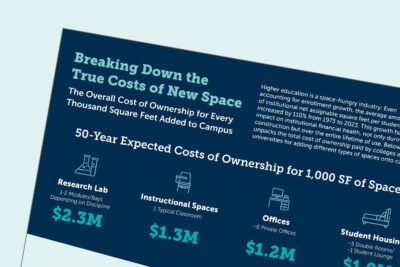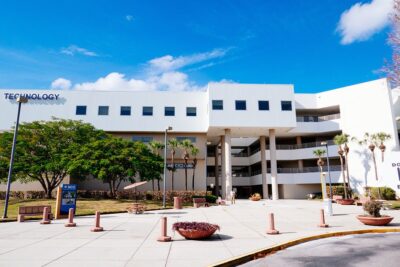Debunking three common (and counterproductive) myths about research laboratory design
State-of-the-art research laboratory design is crucial for recruiting and retaining top faculty talent, as well as enabling investigators to win extramural funding. But misconceptions about research labs often cause leaders to inadvertently waste resources and impede progress toward research growth goals.
Below are three prevalent myths leaders hold about research labs—and their underlying realities.
Myth 1: “Future proofing” research labs will pay off eventually
Many schools are investing in flexible laboratory design with features like moveable benches and plug-and-play infrastructure to reduce the cost and time required to flip the lab. But some have taken this to the extreme, incorporating every imaginable flexible component during the initial lab buildout. Although this “future proofing” can cost three times more per square foot than typical lab construction, leaders believe it’ll ultimately save them money by reducing subsequent costs.
Unfortunately, that hasn’t panned out. Very few schools have actually “flexed” their labs by adapting them for new investigators or types of research. As a result, they’ve never used most of the expensive flexible features they invested in. For example, one school said they have dramatically overinvested in mobile benches, which building occupants have never moved or adjusted. And even when schools have flexed labs, they still ended up paying to customize them for new users. In fact, some Facilities leaders said it can cost more to adapt flexible labs for future occupants due to higher costs and limitations associated with proprietary flexible components.
-
Solution:
Instead of “future proofing” labs, leaders should invest in features that enable short-term flexibility and are most likely to get used by intended occupants. Then, they should track post-installation utilization and adjust their investments accordingly.
Myth 2: Large and highly customized laboratory designs are critical for recruiting new faculty
Leaders have historically used lab size and customization to convince faculty recruits to accept their offers. But today, recruits care about more than just the quantity of lab space—they care about the quality. And that goes beyond just newness or customization. Recruits are looking for user-friendly building floorplans, options for future lab expansion, cutting-edge technology, access to shared equipment, and proximity to colleagues and collaborators. One research leader even speculated that high-profile recruits would forego a larger lab for one that’s half the size if it included access to an ecosystem of research resources.
-
Solution:
By focusing on space quality and adjacencies, leaders can better attract world-class recruits and minimize unnecessary costs associated with footprint expansion and lab customization.
Myth 3: Open and shared labs will increase interdisciplinary collaboration
More schools are designing open and shared labs that house multiple investigators. Along with increasing space efficiencies, leaders hope these labs will break down disciplinary siloes and spur new collaborations. Yet, few have achieved these desired results. While open and shared labs can increase researcher interactions, they often fail to prompt interdisciplinary collaboration since they’re assigned to researchers in the same discipline.
It’s also more common for researchers to initiate collaborations when they’re outside their labs. In fact, one researcher said he doesn’t want colleagues approaching him about collaborations while he’s at the lab bench since it’s distracting and could increase the likelihood of errors or safety hazards.
-
Solution:
Leaders should invest in more “in-between” spaces throughout research buildings—like huddle rooms, meeting spaces, cafes, or communal kitchens—that will promote casual interactions between researchers from different disciplines and units.
More Resources

Breaking down the true costs of new campus space

Putting the Built Environment to Best Use
